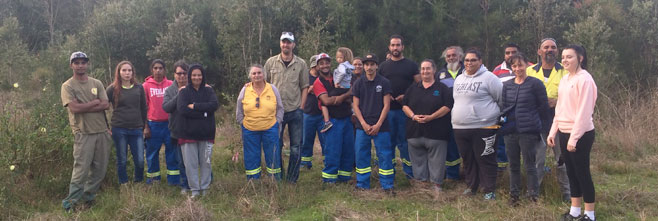
On the 31st May and 1st June the Banbai Enterprise Development Aboriginal Corporation properties of Wattleridge and Tarriwa Kurrukun Indigenous Protected Areas (IPAs) sponsored a professional exchange, learning and development opportunity between their properties and the Coastal IPAs of Minyumai and Ngunya Jargoon. A group of 17 rangers and administrative staff participated in the visit to share knowledge and learn how IPA ranger groups on the coast are managing their properties.
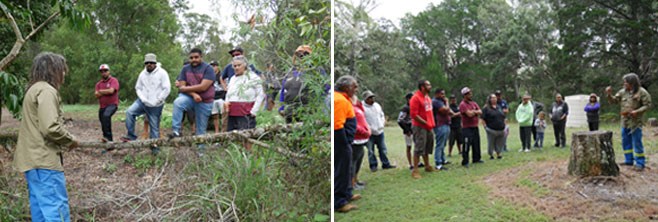
Marcus Ferguson explains the fire and weed management techniques applied at Ngunya Jargoon IPA
The visit to Ngunya Jargoon IPA offered the Banbai rangers insight into the challenges of managing long-unburnt coastal heath communities. After a welcome to country, senior IPA ranger Marcus Ferguson shared with the group some of the innovative techniques that the rangers have developed in order to tackle invasive weeds using fire. The Ngunya Jargoon rangers create small piles of weeds which they burn, slowly moving across the landscape applying fire in a manageable way.
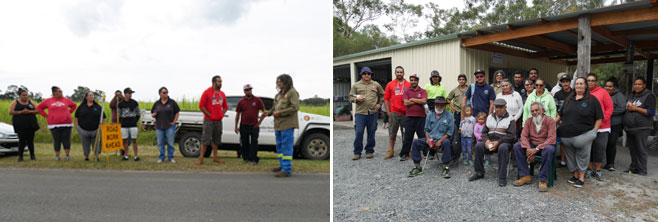
The rangers visit Cabbage Tree Island mission. Rangers from Banbai and Ngunya Jargoon IPA come together to share knowledge and experiences.
The group then visited the Aboriginal mission on Cabbage Tree Island where Marcus shared some of the history of the area during mission times and reflected on how things have changed. The day finished with a visit to Lumley’s Lane to inspect a proposed burn area in the long unburnt heath vegetation. Control lines have been established and the IPA is awaiting approval to burn this area, which contains a small area of peat making the approval process complicated.
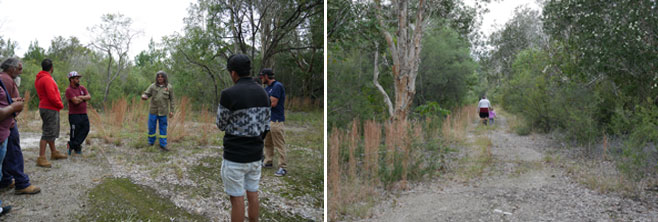
Marcus shares with the group the challenges of burning at Lumley’s Lane.
The visit to Minyumai IPA started with a welcome to country by Traditional Owner and Co-Custodian Doug Wilson in order for all the visitors to feel safe and welcome on country. The Minyumai IPA rangers then led the group to the Magellan (Happy Place) Track that contains interpretive signage and leads down to a beautiful waterfall that at time was not flowing but provided a perfect area to sit and tell stories. Daniel Wilson opened the conversation by reflecting on his connection to the country through his father and grandfather and the broader connections of Minyumai to other landscape features around Evans Head. There followed broader discussions on the importance of getting together to learn from each other and keep cultural connections strong between the different groups.
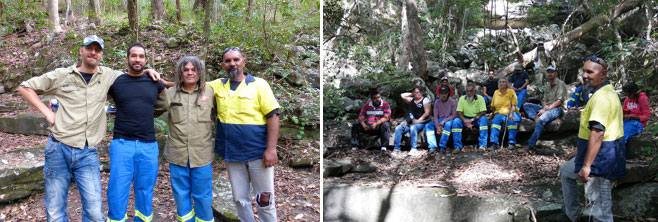
Richard Britingham- Firesticks Project Co-ordinator, Tremane Patterson from Wattleridge IPA, Marcus Ferguson from Ngunya Jargoon IPA and Daniel Wilson from Minyumai IPA. Daniel Wilson shares some stories with the visitors.
The group then visited the Setaria paddocks at Minyumai where the rangers discussed the challenges of managing the site using fire and herbicide to eliminate the Setaria and encourage the regeneration of native trees from the seed bank. The Setaria work at Minyumai has been receiving a lot of interest from other land managers particularly in regards to the use of fire as a management tool.
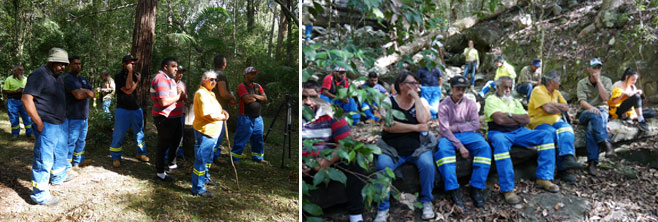
The group took a walk up the Magellan (Happy Place) track to the waterfall.
Following this the group visited the long-term monitoring plots set up by the Firesticks ecologist David Milledge to look at changes to native fauna and flora pre and post fire. One of the main results apparent at the Minyumai plots post burn was the re-sprouting of acacia and the need to implement an appropriate fire regime interval to establish a healthy grassy understory.

An inspection of the Setaria paddocks to discuss ongoing management techniques to restore the area.
After leaving Minyumai the group visited another property that the rangers have been working on for some years in removing Setaria. The result of ongoing management is spectacular with all native species recolonising the area directly from the seed bank. Julie-Anne Coward the owner of the property was kind enough to lead the group through the area and explain the methodology and techniques used for successful regeneration of the area.

Inspecting the setaria paddocks. A tour of a neighbouring property to examine restoration, hosted by Julie-Ann Coward.
The importance of cross cultural exchange between ranger groups was highlighted by the visit of the Banbai rangers to the coastal IPAs. Rangers had the opportunity to share knowledge and reflect on the differences and similarities between each of their properties. Similarly the Banbai rangers went home with an appreciation of the challenges and constraints the coastal IPAs have in managing their properties in very diverse vegetation communities on a part-time basis with limited funding and resources.
The main outcome of the visits was the overwhelming interest in coming together more often to share stories, pass down knowledge and retain cultural connections across the landscape. The IPA rangers are actively re-enforcing the strong cultural pathways between the tablelands and the sea that have been walked, burnt, sung, danced and traded upon by their ancestors for countless generations, and will continue to for many more to come.

